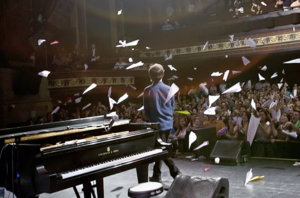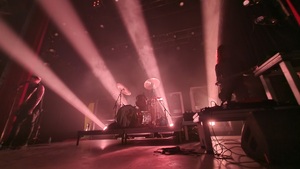Bip-Hop Fest
featuring Taylor Deupree, Richard Chartier, Steve Roden, Tennis, si-{cut}.db, Datach’i
Tonic, New York City, NY • October 9-10, 2001
Nirav Soni
Night 1: Taylor Deupree, Richard Chartier, Steve Roden
Bip-Hop and 12K are two labels that span the many sub-genres of electronic music. While both offer music that exists on the opposite pole of dancefloor fodder, their styles differ completely. Bip-Hop specializes in uncommon electronica of the IDM bent; Tennis and Max Eastley/Spaceheads have released records there, while Arovane, Neotropic, Datach’i, Pimmon, and Mira Calix have all appeared on their remarkable Bip-Hop Generation series of compilations. 12K, on the other hand, present more austere, “experimental” music, more in line with the academic strain of electronic music perpetuated by universities. Richard Chartier appears on multiple 12K albums, as do Shuttle358, Goem, Komet, Tetsu Inoue and Taylor Deupree (operator of said label.) Philippe Petit of Bip-Hop decided to bridge the divide with a two-day festival at Tonic.
The first night was the 12K night. Taylor Deupree, Richard Charier, and Steve Roden were on the bill, so I knew that I had an intensive night of listening ahead of me. Abstraction would be the key term here. Deupree and Chartier both perform exclusively on laptops, so, there is a level of abstraction in the performance itself; the audience isn’t give concrete evidence of what the musician is doing, so there’s a degree of mystery (where are these sounds coming from?) to the show. Deupree went first, and he started his set on a surprising note, with quiet field recordings. He slowly moved into the cyclical sound patterns that pervade his work. There was a tangible narrative quality to the set; a cursory listen would make it seem like his 45 minutes of music were separated into sections that were slowly transitioned into. However, when listening closely, you could hear sounds recur within the overall work; pure tones melded with softly placed clicks and cuts, macrostructures, and microstructures- the interaction between. His set had a lot of dynamic variation, with large, thick heavily processed sounds overcoming smaller constructions.
Richard Chartier shares an affinity with Deupree for nuance in texture and quietness. However, while Deupree’s music has diverse amounts of tonal color and quality, Chartier explores minute timbral and textural events. If there were a word I could use to sum up the set, it would be monochrome. Which isn’t a bad thing, just a tiring one. Chartier focused heavily on density, layering deep rumbles, static hiss, pure tones and high pitched sounds. The set operated in contrasts, the high end was pitted against the low end, loud versus quiet, and small gestures against big ones. It was very rigorous, and very intense; I just wished that Tonic was offering coffee.
LA-based Roden does many of site-specific installations, using the venue itself as a medium for sonic creation. His recordings are beautifully subtle; he has a wonderful ear for texture and density, and can make scraping a contact microphone across his forearm rapturous. He’s closely aligned with Brandon LaBelle, another sound-artist, and has released a handful of records on Trente Oiseaux, a label that explores the quiet and low-velocity. He was the only musician that night to not use a laptop. Instead, he had a variety of soundmakers on his table, amongst which were a beaker of water, delay pedals, contact microphones, a mixer and a small copper pipe. He introduced the set by slowly rubbing the pipe along the amplified leg of the table, sampling, looping and layering the result. He moved onto other things, including dropping a contact microphone into the beaker of water, quieter, slow contact microphone work and subtle feedback explorations. Roden’s work has a beautiful sense of space, his sounds never intrude upon it; they gently seek equilibrium with the silence. On record, sometimes it seems like the music is there not to break the silence, but to augment and call attention to it. His set was a wonderful conclusion to a night of challenging sonic exploration. 12K are located in New York, so I eagerly anticipate any more performances by related artists.
Night 2: Tennis, si-{cut}.db, Datach’i
The next night was quite different in comparison. Bip-Hop is part of the growing number of electronic labels merging bumpin’ dancefloor thumpin’ with living room listening. The most tangible connection between the two nights of music was the glowing Macintosh apple. Ben Edwards of Tennis, however, put it to a very different use than Deupree and Chartier. Edwards is also known by the alias Benge, and for the Tennis project, he has teamed up with Douglas Benford of si-{cut}.db. They started the night on a very positive note.with dense layers of glitchy ambience over driving beats, rooted in both digi-dub and minimal techno, occasionally Chain Reaction-esque, without the sterility. The set started out tenaciously, synth pads; small clicks and pops, on top of slowly evolving rhythms. The set gained momentum, bringing in more pulsing beats and denser atmospheres. By its end, Tennis had built up that jackbooted power that some of the early ’90s Industrial shot for (and, generally speaking, failed miserably). The beats were tougher, and the pool of sounds was thick and dense. Their music was beautifully complemented by the visuals of Phase 4, who accompanied all of the musicians during the concert. His material was nuanced, very often loop based, and mostly abstract. He occasionally used a recognizable image, which greatly altered the tenor of the visuals.
The next act was si-{cut}.db. Through Douglas Benford’s set, it was easy to ascertain what he contributes to Tennis. His is the rhythmic, the dubby, the languid; his set floated by like it was a dream. I have a feeling that the melodic elements were much more complex than I immediately apprehended at the time, but I succumbed to the flow of the set. Very nice, deep and dreamy.
Datach’i was the absolute polar opposite; a tidal wave of noise and chaos across the blissout of si-{cut}.db. I’d been waiting a long time to see Joseph Fraoli in action, and he did not disappoint in any way. For the uninitiated, Datach’i is a flood of screaming feedback, collapsing breakbeats, blinding noise, and a little hint of Atari video game goofiness, just enough, so that Datach’i is dissociated from the DJ Scud, Nomex, Christoph de Babalon, C8, and Digital Hardcore school of noise violence. Live, his music is even more overwhelming than on record. He ran through a vast range of material, with some familiar bit cropping up, but not enough to be able to discern anything resembling a song. His set was fairly short, but filled with ideas and noiseterrorbliss. I left the show grinning like a little kid.












